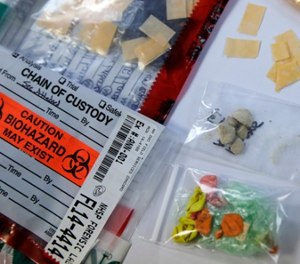
Corrections agencies are often not aware of available grants for the purchase of critically needed drug detection and interdiction equipment
Recent drug exposures to corrections staff, and the rise in inmate overdoses in correctional facilities reported over the last few weeks, is cause for alarm.
Several events of synthetic marijuana (K2) and opioid/fentanyl exposure in prisons and jails have been reported in states such as Pennsylvania , Ohio and Arkansas . Other states, including Maryland , have taken precautionary measures in attempts to thwart a similar event in their facilities. Many staff became ill from these exposures, with many corrections departments on lockdown for days.
Whether you are a warden, corrections officer, sheriff’s deputy, investigator, teacher or nurse you know the dangers of narcotics exposure to yourself and those you protect every day. Correctional facilities need proper equipment such as trace detection tools , ion scanners and body scanners to not only detect and identify substances, but also prevent the drugs from entering the facility in the first place. Personal protective equipment such as Tyvek suits, masks, gloves and safety glasses are also critically important to protect from the effects of exposure to these substances.
Finding funding to cover the cost of this equipment can be challenging. Many state and local corrections budgets are stretched due to rising personnel costs, increases in the inmate population and the cost of maintaining aging facilities.
Corrections agencies are often not aware of the variety of grant funding that may be available to cover the cost of critically needed drug detection and interdiction equipment. Here are a few federal, state and foundation grants to consider along with some strategies on how to secure these funds.
Many large corporations have established foundations or giving programs that will support state and local government agencies. Several of these have a focus on officer safety and wellness including Target and Firehouse Subs .
Consider grocery stores like Kroger , Aldi and Safeway that all provide grants aimed at keeping communities safe.
Private foundations such as the Gary Sinise Foundation or the Spirit of Blue are also huge supporters of first responders with a focus on officer and staff safety.
Also approach your local community foundation. The Foundation Center is an excellent source for finding the community foundation located in your correctional facilities geographic area.
A final strategy to consider is joining together with your law enforcement partners and other community stakeholders on a collaborative application. One agency would take the lead to apply for funding to purchase multiple narcotics detection and testing units and x-ray devices.
Several law enforcement agencies across a state or jurisdiction could benefit from this approach and receive this much needed equipment.
Many federal funders encourage this approach and require that a federal or state agency, or regional drug task force take the lead.
Examples of federal grant opportunities to consider for this approach include:
Consider all of these funding sources as possible resources for supporting much-needed drug detection, interdiction and personal protection equipment. Approach the funding sources noted above or agency representatives to discuss your project, relay the urgency for getting the equipment now and apply for these grants as they become available.
The team at PoliceGrantsHelp is ready to assist. Our grant assistance program includes a number of options for departments seeking assistance in securing grant funding to support the work you do for our communities every day.
Copyright © 2025 CorrectionsOneGrants.com. All rights reserved.
